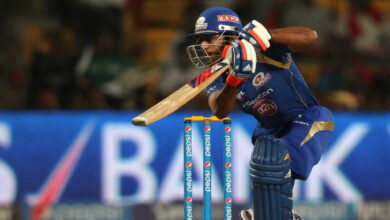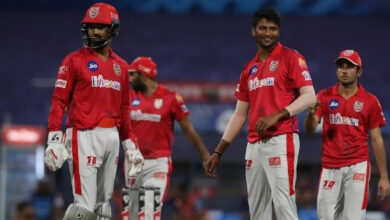For T20 big-hitters like Asif Ali and Hardik Pandya each ball is a virtual set-piece, a standalone event

In this Asia Cup week, Pakan Cricket Board’s Twitter handle posted a short video featuring their designated six-hitter Asif Ali. In the clip about his training method, Asif gave a rare peek into the mind of T20’s most influential players – the archetype mercurial lower-order batters with power to deliver decisive blows that probably decide nine out of 10 games in this format of fine margins.
Unwittingly, the young man, sharing his uncomplicated batting process, gave clues about the changing perception of players about the limited-overs game and the possible course the sport would take in the future.
The 30-year-old, a high-value power-hitter on the tape-ball circuit till he was in his 20s, revealed that his T20 batting was about clinically breaking down his innings treating each ball as a virtual set-piece contest between bat and ball. Other reputed T20 finishers, the poster boys of franchise cricket around the world like Hardik Pandya and Keiron Pollard, have also followed the same game plan.
Asif Ali – the power-hitting prodigy! 💪
🗣️ Watch him discuss the strategy for hitting towering sixes 🔥
📒: https://t.co/elMGU3IzE0#AsiaCup2022 pic.twitter.com/digtNI1txn
— Pakan Cricket (@TheRealPCB) August 23, 2022
The good old elaborate plot of setting up batsmen over six balls has now been put on the back burner. It’s not that ‘three away balls, followed the surprise sucker punch of the in-cutter’ has become obsolete but T20 are increasingly about treating each ball as a standalone event that has no real correlation to the previous or subsequent deliveries.
T20 cricket, especially for its MVPs who take stage when the game is on the boil, is no longer seen as a 20-over game in true sense. It’s now a contest of 120 balls.
Asif starts explaining his net session routine in the lead-up to T20 games, like the Asia Cup where Pakan play India on Sunday.
“I try to hit about 100 to 150 sixes in training so that I can hit those 3-4-5 sixes in a game. At the position I bat, invariably the team needs to score about 10 or 11 or at times even at 14 runs per over. So, there is a lot of pressure on me, plus there is of course the pressure of playing international cricket. So, in the practice sessions and matches, we keep in mind the same condition and pressure,” he says.
While the “150 sixes” part of his statement made it to the headlines, the thought behind this repetition didn’t get the attention it deserved. The early part of the video has Asif facing a large number of balls of varying line and length. With the ‘150’ target in his mind, he would deal with them with the intention of despatching them over the boundary line. His feet, head and general shape would remain still. Asif’s sixes are about his keen eye, anticipation and the measured movements of his arms.
Ever-evolving game
Until very recently, batters tasked to step up the run rate would use phrases like “preferred scoring areas” and would hope to get “the ball in their arc”. It conveyed the boundaries they would target and the kind of deliveries they would want the bowlers to bowl to them.
In the highly-competitive T20 franchise leagues, teams are armed to the teeth with data and other analytical tools to dissect the strengths and weaknesses of players. This is not an age of single-weapon cricketers. To succeed in death overs these days, players need much more than just a slog to the cow corner or a yorker at the base of the stumps.
If not 360 degrees, virtually every T20 big hitter is a 180- degree batsman. Since bowlers keep adding variety and are known to mix up their deliveries wisely, batters can’t premeditate or second-guess. They need a range of strokes that deal with anything that is thrown towards them.
That’s the reason batters like Asif are prepared for every eventuality. “It is not like I have pre-decided that I will hit in the mid-wicket region or straight. I think that wherever the ball is pitched, I will hit. I think that whatever is the type of delivery – pitching outside off, length ball, yorker or anything, based on the ball I will hit the shot,” he says.
In years to come, teams would want to own the match situations when batters are looking for sixes with bowlers doing their best to stop them. Like in football, they would invest heavily in research and master these set-pieces. This might see them borrowing new ideas from other fields and adopting them. Just like Tottenham Hotspur.
The big story of this season’s English Premier League is Tottenham’s ability to score from corners. What was otherwise a blind spot for them is proving to be strength. The recent addition to their support staff – a 69-year-old one-time banker and now set-piece coach Gianni Vio – is said to have made a difference. After their game against Wolverhampton Wanderers in which they scored their third goal from a dead-ball situation, players said that Vio deserves to get a pay hike.
The number-cruncher with the knack for working on angles and looking for space had earlier worked with the Italian team during the European Championship. Vio is said to have conjured 4,000 different routines keeping in mind the strength of his players and the opponents’ weakness.
While set-pieces in football are few and far between, T20 is a game of 120 set-pieces. No wonder, the newer formats like The Hundred, and even the Chris Gayle- promoted Caribbean enterprise 6ixty, in a not subtle hint, undermined the long-celebrated ‘overs’ and underlined the importance of ‘balls’. The signs were there but the world seemed to have missed cricket’s sliced-bread moment.
Please send your feedback to sandydwivedi@gmail.com
Sandeep Dwivedi
National Sports Editor
The Indian Express







